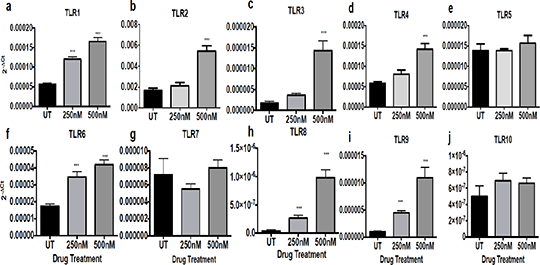Pharmacological Inhibition of DNA Methyltransferases alters Toll-Like Receptor Expression Introduction: Toll-like receptors (TLRs) are pattern recognition receptors that recognise components of bacteria, viruses and endogenous stress. TLR signalling culminates in the production of a variety of cytokines, which initiate the inflammatory response. The expression of these receptors varies with cell type and with disease progression (1). DNA methylation is an epigenetic mechanism, which the cell employs to regulate gene expression. A family of enzymes known as DNA methyltransferases (DNMT) catalyses the addition of a methyl group to the 5’ position of cytosine in DNA (2). We hypothesize that DNA methylation regulates TLR mRNA expression. Methods: THP-1 monocytic cells were treated with 250 or 500 nM of the DNMT inhibitor, 5-aza-2-deoxycytidine (5-azdc), for 72 hours, after which time cells were analyzed for gene expression (n = 9) using quantitative polymerase chain reaction. Data was expressed as mean relative cycle threshold +/- S.E.M. (no units) using the 2-ΔΔCt method. Statistical comparisons were carried out using one-way ANOVA followed by suitable post-hoc tests. Results: Basal mRNA expression for certain TLRs was significantly increased in THP-1 cells treated with 250 nM of 5-azdc compared to untreated cells: TLR1, TLR6, TLR8 & TLR9 (Fig 1a, 1f, 1h & 1i respectively; all p<0.001). In addition, expression for certain TLRs was significantly increased in cells treated with 500 nM 5-azdc compared to untreated cells; TLR1, TLR2. TLR3, TLR4, TLR6, TLR8 & TLR9 (Fig 1a, 1b, 1c, 1d, 1f, 1h & 1i respectively; all p<0.001). No significant effect on TLR 5 (Fig 1e), TLR7 (Fig 1g) or TLR10 (Fig 1j) expression was seen with either concentration of inhibitor. 
Conclusion: Our findings indicate that DNA methylation is implicated in the regulation of mRNA of certain TLRs. Our data suggests that DNA methyltransferase enzymes and inhibitors could be used to modulate the expression of innate immune receptors in disease states. References: (1) Akira S et al., Pathogen recognition and innate immunity. Cell. 2006 124(4): 783-801.(2) Bestor TH. The DNA methyltransferases of mammals. Hum Mol. Genet. 2000 (16): 2395-402. |


